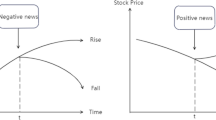Abstract
Share turnover is a key indicator for investing in the stock market, which represents how easy or difficult it is to trade a stock. Several techniques have been proposed to predict share turnover values. However, they are often inaccurate because they utilize single-view models that have an incomplete picture of the temporal dynamics. To address this issue, a multi-view time series model (MvT) is proposed to capture temporal dynamics using three views on two data groups. The temporal dynamics of target turnover data and exogenous turnover data are captured by a view generation component. The component generates three views in three different aspects. The predictions are then made by a view combination component and a full connected layer. Extensive experiments on two real stock datasets show the effectiveness and efficiency of the proposed MvT model, when compared with ten algorithms on four groups of stock data in terms of three metrics.





Similar content being viewed by others
Explore related subjects
Discover the latest articles, news and stories from top researchers in related subjects.Data Availability
The data used to support the findings of this study are available from the corresponding author upon request.
Notes
Southbound trading refers to the trading of certain SEHK securities from mainland investors. It is likely named so because Hong Kong is located south of Shanghai and Shenzhen.
References
Chao G, Sun J, Lu J, Wang A-L, Langleben DD, Li C-S, Bi J (2019) Multi-view cluster analysis with incomplete data to understand treatment effects. Inf Sci 494(2):146–168
Chao G, Sun S (2016) Consensus and complementarity based maximum entropy discrimination for multi-view classification. Inf Sci 367(7):296–310
Chao G, Sun S (2018) Semi-supervised multi-view maximum entropy discrimination with expectation laplacian regularization. Inf Fusion 45(2):296–306
Cho K, van Merrienboer B, Bahdanau D, Bengio Y (2014) On the properties of neural machine translation: Encoder-decoder approaches. In: Proceedings of 8th Workshop on Syntax, Semantics and Structure in Statistical Translation. Association for Computational Linguistics, Doha, pp 103–111
Kim HY, Won CH (2018) Forecasting the volatility of stock price index: a hybrid model integrating lstm with multiple garch-type models. Expert Syst Appl 103:25–37
Lee C-Y, Soo V-W (2017) Predict stock price with financial news based on recurrent convolutional neural networks. In: Proceedings of the Conference on Technologies and Applications of Artificial Intelligence. IEEE, Taipei, pp 160–165
Lin H, Zhou D, Liu W, Bian J (2021) Learning multiple stock trading patterns with temporal routing adaptor and optimal transport. In: Proceedings of the 27th International Conference on Knowledge Discovery and Data Mining. ACM, Virtual Event, pp 1017–1026
McNally S, Roche J, Caton S (2018) Predicting the price of bitcoin using machine learning. In: Proceedings of the 26th Euromicro International Conference on Parallel, Distributed and Network-based Processing, Cambridge, pp 339–343
Minami S, et al. (2018) Predicting equity price with corporate action events using lstm-rnn. J Math Finance 8(01):58
Ozbayoglu AM, Gudelek MU, Sezer OB (2020) Deep learning for financial applications : a survey. Appl Soft Comput 93:106384
Selvin S, Vinayakumar R, Gopalakrishnan E, Menon VK, Soman K (2017) Stock price prediction using lstm, rnn and cnn-sliding window model. In: Proceedings of the international conference on advances in computing, communications and informatics. IEEE, Udupi, pp 1643–1647
Sermpinis G, Stasinakis C, Dunis C (2014) Stochastic and genetic neural network combinations in trading and hybrid time-varying leverage effects. J Int Financ Markets Inst Money 30:21–54
Sezer OB, Gudelek MU, Ozbayoglu AM (2020) Financial time series forecasting with deep learning: a systematic literature review: 2005–2019. Appl Soft Comput 90:106181
Shih S, Sun F, Lee H (2019) Temporal pattern attention for multivariate time series forecasting. Mach Learn 108(8-9):1421–1441
Sun S, Chao G (2013) Multi-view maximum entropy discrimination. In: Proceedings of the 23rd International Joint Conference on Artificial Intelligence. AAAI Press, Beijing, pp 1706–1712
Sun S, Xie X, Dong C (2019) Multiview learning with generalized eigenvalue proximal support vector machines. IEEE Trans Cybern 49(2):688–697
Wang J, Yang Y, Mao J, Huang Z, Huang C, Xu W (2016) Cnn-rnn: a unified framework for multi-label image classification. CoRR arXiv:1604.04573
Wang Y, Gu J, Zhou Z, Wang Z (2015a) Diarrhoea outpatient visits prediction based on time series decomposition and multi-local predictor fusion. Knowl-Based Syst 88:12–23
Wang Y, Li J, Gu J, Zhou Z, Wang Z (2015b) Artificial neural networks for infectious diarrhea prediction using meteorological factors in shanghai (china). Appl Soft Comput 35:280–290
Wang Z, Cai B (2021) COVID-19 cases prediction in multiple areas via shapelet learning. Appl Intell 51:1–12
Wang Z, Huang Y, Cai B, Ma R, Wang Z (2021a) Stock turnover prediction using search engine data. J Circ Syst Comput 30:2150122:1–2150122:18
Wang Z, Huang Y, He B (2021B) Dual-grained representation for hand, foot, and mouth disease prediction within public health cyber-physical systems. Softw Practice Exper 51:2290– 2305
Wang Z, Huang Y, He B, Luo T, Wang Y, Fu Y (2020) Short-term infectious diarrhea prediction using weather and search data in Xiamen, China. Sci Programm 2020:8814222:1–8814222:12
Wang Z, Wang Z, Lin Y, Liu J, Fu Y, Zhang P, Cai B (2021c) Prediction of HFMD cases by leveraging time series decomposition and local fusion. Wirel Commun Mob Comput 2021:5514743:1–5514743:10
Xie X (2018) Regularized multi-view least squares twin support vector machines. Appl Intell 49 (2):688–697
Xie X, Sun S (2019) General multi-view learning with maximum entropy discrimination. Neurocomputing 332:184–192
Xie X, Sun S (2020a) General multi-view semi-supervised least squares support vector machines with multi-manifold regularization. Inf Fusion 62:63–72
Xie X, Sun S (2020b) Multi-view support vector machines with the consensus and complementarity information. IEEE Trans Knowl Data Eng 32(12):2401–2413
Xu C, Tao D, Xu C (2013) A survey on multi-view learning. CoRR arXiv:1304.5634
Zhang B, Chan JCC, Cross JL (2020) Stochastic volatility models with ARMA innovations: An application to G7 inflation forecasts. Int J Forecast 36:1318–1328
Zhang L, Aggarwal CC, Qi G (2017) Stock price prediction via discovering multi-frequency trading patterns. In: Proceedings of the 23rd International Conference on Knowledge Discovery and Data Mining. ACM, Halifax, pp 2141–2149
Zhao J, Xie X, Xu X, Sun S (2017) Multi-view learning overview: Recent progress and new challenges. Inf Fusion 38:43–54
Zhou X, Pan Z, Hu G, Tang S, Zhao C (2018) Stock market prediction on high-frequency data using generative adversarial nets. Math Probl Eng 2018:1–11
Acknowledgments
This work was supported in part by Jimei University (nos. ZP2021013, ZQ2018008 and ZP2020043), the Science project of Xiamen City (no. 3502Z20193048), the Education Department of Fujian Province (CN) (nos. JAT200277, JAT200232, JAT170327 and JAT200273), and the Natural Science Foundation of Fujian Province (CN) (nos. 2019J05099 and 2021J01859).
The authors would like to thank the editor and anonymous reviewers for their helpful comments in improving the manuscript quality.
Author information
Authors and Affiliations
Corresponding author
Ethics declarations
Conflict of interest
None.
Additional information
Publisher’s note
Springer Nature remains neutral with regard to jurisdictional claims in published maps and institutional affiliations.
This article belongs to the Topical Collection: Special Issue on Multi-view Learning
Guest Editors: Guoqing Chao, Xingquan Zhu, Weiping Ding, Jinbo Bi and Shiliang Sun
Rights and permissions
About this article
Cite this article
Wang, Z., Su, Q., Chao, G. et al. A multi-view time series model for share turnover prediction. Appl Intell 52, 14595–14606 (2022). https://doi.org/10.1007/s10489-021-02979-y
Accepted:
Published:
Issue Date:
DOI: https://doi.org/10.1007/s10489-021-02979-y




